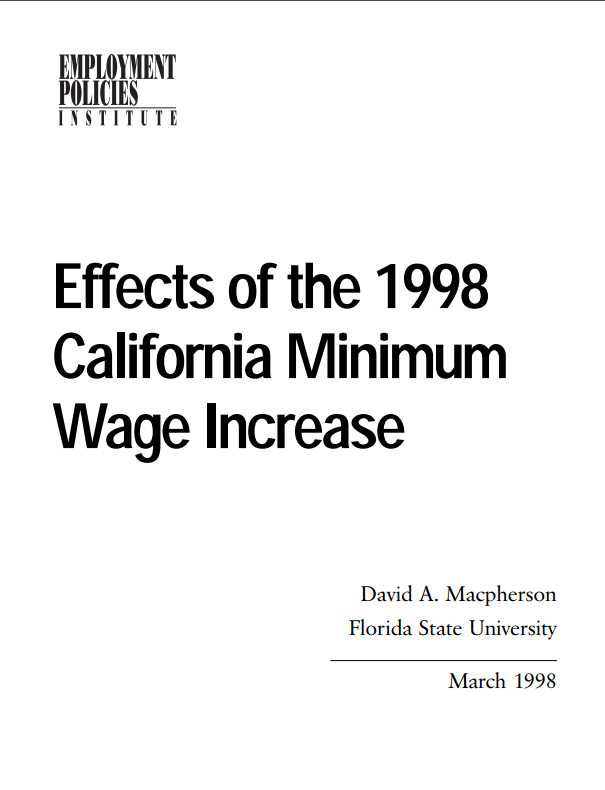Based upon an analysis of Labor Department data, Dr. David Macpherson finds the 1998 California minimum wage hike from $5.15 to $5.75 per hour will cause more than 25,000 workers to lose job opportunities. As a consequence, California workers will lose approximately $230 million in annual income. At the same time, minimum wage employers will see their labor costs rise by $790 million per year in order to provide minimum wage workers an increase in average family income of only 2%.
On February 12, 1998, President Clinton proposed raising the federal minimum wage in two annual 50-cent increments, from $5.15 to $5.65 and then $6.15 per hour. In support of this proposal, the President and others claim that minimum wage increases of such magnitudes do not cost jobs, and that the benefits of these increases accrue primarily to poor adults trying to raise families. With this legislative proposal on the table, it is instructive to read Dr. Macpherson’s study of expected effects from California’s statewide increase in its minimum wage from $5.15 to $5.75, which is effective March 1, 1998.
Who will be affected?
Macpherson finds that fewer than one-fifth of the workers who will be affected by the minimum wage increase are the sole breadwinners in families with children. The annual family income of affected workers averages more than $30,000, and in some localities, e.g., San Francisco, exceeds $40,000. These income figures indicate that most minimum wage workers are members of families with multiple workers. Only one in five affected workers lives in a family with income of less than $10,000.
Of affected workers, many are very young; 20% are teens aged 16-19 and an additional 23% are young adults aged 20-24; 27% are living with a parent or parents. More than half of affected workers have never been married.
How will they be affected
Of the 25,000 lost job opportunities resulting from the California increase, Hispanic workers will account for more than half. Almost half of the burden will be borne by workers with annual family incomes less than $20,000, as well as workers under age 25. One-third of the lost jobs will be in the retail sector, and almost another third will be in the service sector. Geographically, more than half of the lost jobs will be in the Los Angeles area. Dr. Macpherson estimates that the $790 million in additional annual labor costs associated with the California minimum wage increase will fall disproportionately on retail employers ($238 million) and service-sector employers ($225 million), and on employers in the Los Angeles area ($300 million).
Of the total income gains generated by the wage hike, only one dollar in five will go to workers living in families with incomes of less than $10,000. Hence, the wage hike appears to be an inefficient policy tool for raising low-income workers out of poverty. The average increase in family income of affected workers will be a very modest 2.3%.
Conclusion
This study demonstrates that increases in the minimum wage entail real consequences and costs. Even a 50-cent (or ten percent) increase can cause significant job loss and impose substantial costs on employers and job seekers. At the same time, such an increase does little to combat poverty, even among those that don’t lose their jobs.
